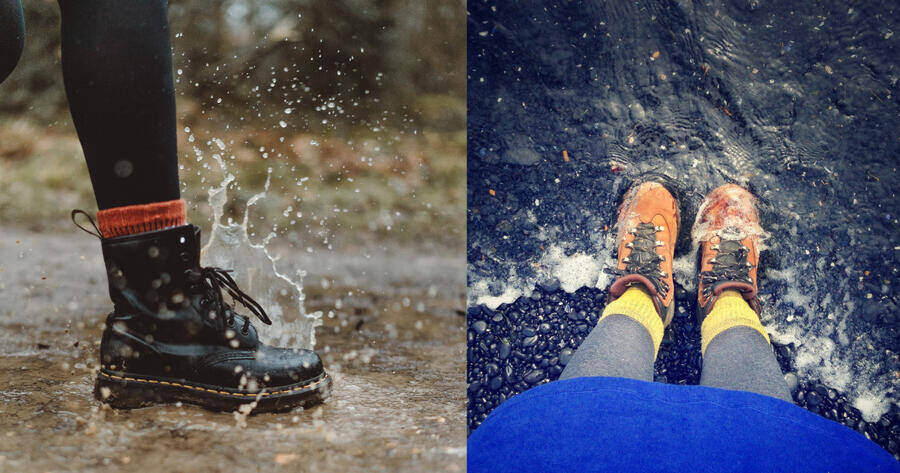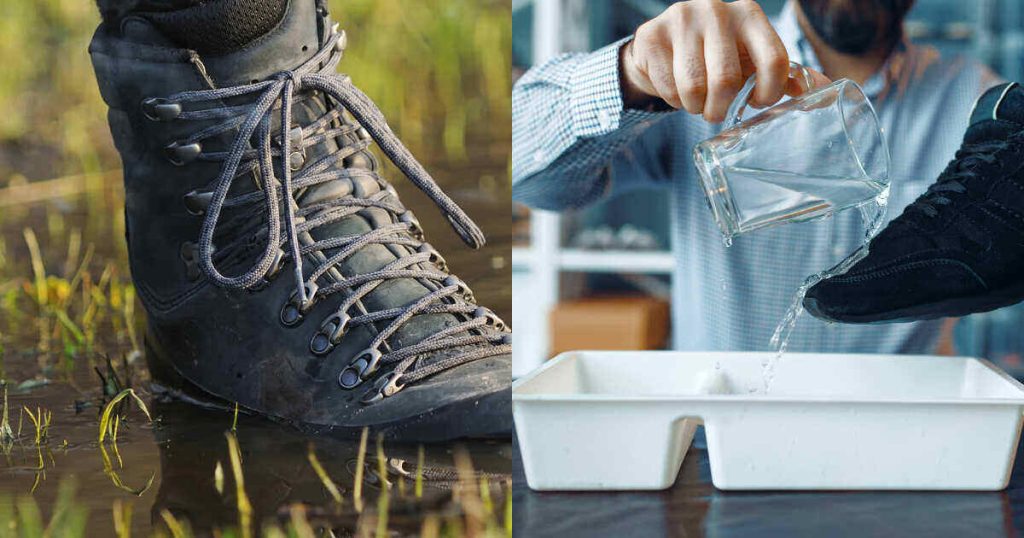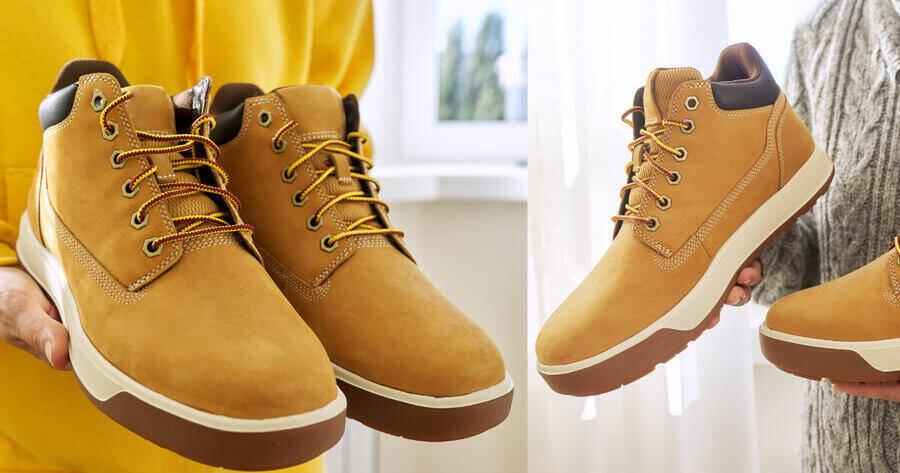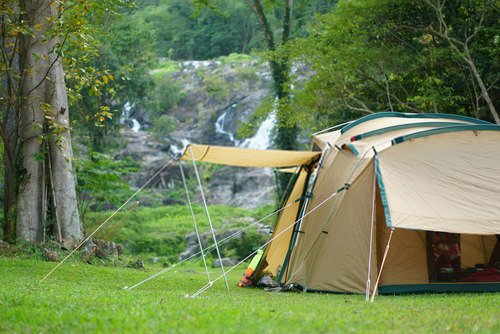Waterproof Vs Water Resistant Boots: 6 Key Differences
We’ve all seen people using the terms ‘waterproof’ and ‘water-resistant’ interchangeably. But are they really alike? When it comes to comparing footwear, we need clarity.
The basic difference between waterproof vs water resistant boots is that you can submerge waterproof boots in the water without damaging them whereas water-resistant boots will only endure moisture to a certain level.
It’s not simple to explain the difference in those words. So, let’s dive a bit deeper.

Waterproof Vs Water Resistant Boots: What Do They Mean?
There are several differences when we are comparing these two types of boots. But first, it’s important to get our basics right. The term water resistant refers to when something can withstand water to a certain level. For instance, water-resistant boots are protected from water if it’s lightly raining, or water splashes on them.
However, you cannot submerge water-resistant boots into the water. These boots go through a test before they are labeled as water-resistant. The test determines how much water it can withstand before it leaks inside the boots. The amount of water pressure that can label a shoe as water-resistant is 200 mm.
Waterproof boots, on the other hand, can withstand water even if you submerge them in the water. They are usually made of different materials and cost more than water-resistant boots.
Not understanding the difference between these two terms is what creates disappointment. When something is advertised as water resistant and they don’t perform well when they’re entirely submerged in the water, people tend to get disappointed.
Nevertheless, you need to understand that there’s a limit to which a water-resistant product can withstand the effect of water. So, make sure you’re paying extra attention when choosing anything labeled as water-resistant and waterproof.
Waterproof Vs Water Resistant Boots: 6 Basic Differences
The terminologies are not the only thing that differs from one another in this case. There are some significant differences between waterproof and water-resistant boots. Let’s take a brief look at them.
| Aspect | Waterproof Boots | Water-Resistant Boots |
|---|---|---|
| Material | Nylon, waterproof fabrics, leather | Canvas, leather, rubber with coating |
| Price | Usually more expensive | Generally more affordable |
| Breathability | Less breathable due to non-porous materials | More breathable |
| Effectiveness | Long-term protection from moisture and water | Short-term protection from moisture |
| Durability | Withstands harsh weather, lasts longer | Less durable than waterproof boots |
| Insulation | Better insulation, retains heat | Less effective insulation |

Material
Water-resistant boots can be made of canvas, leather, or rubber. Regardless of what material is used, there is usually a protective coating that makes the boots water-resistant.
Waterproof boots are usually made of nylon, waterproof fabrics, or leather. The outsole of waterproof boots can feature rubber, polyurethane, or neoprene. These materials are non-porous, making them perfect for the waterproof feature.
Price
As you can guess, waterproof boots are usually more expensive than water-resistant ones. So, if you are thinking about getting a waterproof pair, make sure to keep your budget higher than usual.
Breathability
Water-resistant boots are certainly more breathable than waterproof boots. Even with the coating that makes a pair of boots water-resistant, these boots are usually a lot more breathable compared to waterproof boots.
The non-porous materials used for making waterproof boots prevent water from getting water inside the shoes. As a result, the breathability of the boots get affected
Effectiveness
Both boots come with some upsides and downsides. Which one is better for you depends on the purpose. If you need a pair for long-term protection from moisture and water, it’s better to invest in a pair of waterproof boots.
On the other hand, if your primary concern is breathability, price, and short-term protection from moisture, water-resistant boots will be a better choice.
Durability
Waterproof boots win this round with flying colors. Because of their waterproof feature, they can withstand harsh weather and last longer than water-resistant boots.
Insulation
The waterproof materials also come in handy when you’re in search of better insulation. Heat can’t escape and air can’t enter waterproof shoes, making them stronger against temperature.
So, if it’s freezing cold outside and you want your feet to be warm, waterproof boots will certainly perform better than water-resistant boots.
Advantages Of Waterproof And Water Resistant Boots
Let’s summarize what advantages you will get if you go for any of these boots.
| Advantages | Waterproof Boots | Water-Resistant Boots |
|---|---|---|
| Protection | Provides highest protection from dirt and water | Provides a level of moisture resistance |
| Insulation | Offers improved insulation, keeps feet warm | More breathable, comfort for longer periods |
| Styles | Available in wide range of styles | Lightweight, stylish design |
| Longevity | Typically lasts longer than many other boots | Often comfortable |
| Water Submersion | Can be submerged in water without damage | Suitable for most situations, slip prevention |
| Versatility | Suitable for various weather conditions, all-season choice | Easy to clean, versatile |
| Affordability | Comparatively higher cost | Generally more affordable |
| Slip Prevention | Can offer better grip | Helps prevent accidental slips |
| Comfort | May be less breathable, depending on material | Often more comfortable than some other boot options |
| Moisture Prevention | Keeps feet dry and prevents moisture | Provides a level of moisture resistance to keep feet drier |

Waterproof Vs Water Resistant Boots: Which One Is Better And Why?
| Aspects | Water-Resistant Boots | Waterproof Boots |
|---|---|---|
| Price & Breathability | Win in terms of price and breathability | May have a higher price, less breathable |
| Insulation & Durability | May have less insulation and durability | Offers better insulation, durability against water |
| Weather Consideration | Suitable for light moisture, drizzles, and splashes | Essential for heavy rain, muddy areas |
| Suitability for Activities | Suitable for walking, hiking in various conditions | Necessary for heavy rain, mud-prone activities |
| Long-Term Investment | May be a more economical choice initially | Ensures shoes remain unaffected by water over time |

As you can understand from today’s discussion, the better choice could be any one of them depending on what you are looking for. When you’re comparing these two options based on price and breathability, water-resistant boots will certainly win.
On the contrary, if you are concerned about insulation, durability, and keeping the shoes unaffected by water, waterproof boots are the ones you should invest in.
It’s smart to think about the weather and the purpose before buying a pair. if you work indoors and don’t want to spend a lot of money on your shoes, water-resistant boots will do fine.
They can excellently withstand light moisture, drizzles, and splashes. You can walk and hike easily wearing water-resistant shoes.
Nevertheless, if you visit somewhere muddy on a regular basis, or it rains heavily in your area, it’s very important that you invest in a pair of high-quality waterproof shoes.
Initially, the price difference between these two options may make you think that it’s better to get a pair of water-resistant boots.
However, if you ruin your shoes with water, there is no use in saving that small amount of money.
Final Words
There you have it. The detailed differentiation between waterproof vs water-resistant boots. If you are about to buy a new pair of boots, it’s smart to get your facts straight.
No matter how much someone says waterproof and water-resistant boots are the same, they are not. Now that you know what to measure to differentiate these two, you can be a better buyer without spending your money in the wrong place.
References
- https://www.overlookboots.com/blogs/boots/waterproof-vs-water-resistant-vs-water-repellent-boots-what-is-the-difference
- https://www.vionicshoes.com/blog/whats-the-difference-between-waterproof-and-water-resistant-boots/






